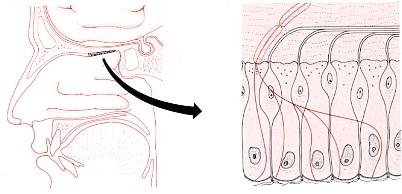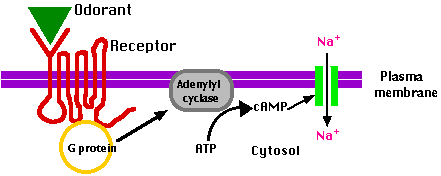
Smell depends on sensory receptors that respond to airborne chemicals. In humans, these chemoreceptors are located in the olfactory epithelium — a patch of tissue about the size of a postage stamp located high in the nasal cavity. The olfactory epithelium is made up of three kinds of cells:

Odorant receptors represent one family of many types of G-protein-coupled receptors (GPCRs). Some other examples of GPCRs:
|
Humans can discriminate between hundreds, perhaps thousands, of different odorant molecules, each with its own structure. How can one kind of cell provide for this?
The mechanism:
Although a single olfactory neuron contains over a thousand receptor genes, there is only a single enhancer capable of binding to the promoters of these genes and turning them on. (There are, of course, two alleles of the enhancer but only one is active [one is methylated; the other is not]. Presumably, when the active enhancer encounters the promoter of an olfactory gene, it turns it on and ceases its search. Thus only one olfactory receptor gene gets to be expressed in a single cell, but which one is a matter of chance.
In mice, the enhancer is on chromosome 11. Although several olfactory genes are also on that chromosome, many others are scattered over several other chromosomes. Nonetheless, it has been demonstrated (e.g., by FISH analysis) that the enhancer on chromosome 11 can find and bind to the promoter of an olfactory gene on other chromosomes not just those on #11. (Link to other examples of "kissing" chromosomes.)
This provides the basis for combinatorial diversity. It would work like this:
Assume that| Many mammals have a separate system for detecting pheromones — airborne molecules that elicit mating behaviors. Link to a discussion. |
| Welcome&Next Search |